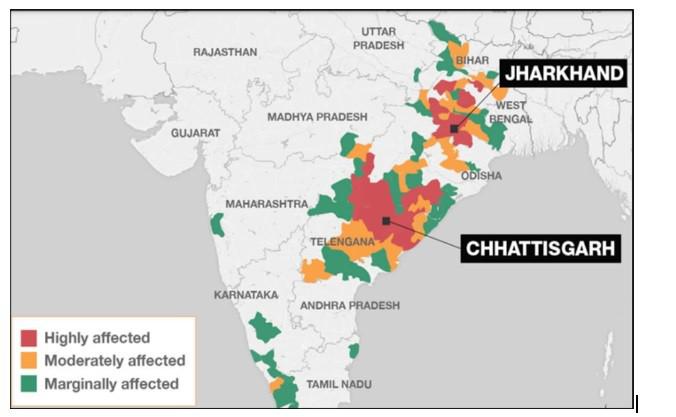Mains Daily Question
Dec. 27, 2023
Q.3) The dismal polling turnout in the Maoist-affected areas of Chhattisgarh is a pointer that democracy needs to be strengthened at the grassroots. In light of the statement, highlight the factors contributing to Left-wing extremism and outline the measures undertaken by the government to eliminate LWE. (10M/150W)
|
Approach Introduction: Briefly introduce with meaning of LWE and the highlight the low voter turnout in recently concluded elections Body: Heading 1: Reasons behind LWE Heading 2: Steps taken by Government( Security and Development) Conclusion: Conclude with key remarks on how to eradicate LWE |
Answer
Left-wing extremism refers to political ideologies and movements that advocate for radical social, economic, and political changes with the aim of establishing a more equitable and classless society. In the recently concluded Chhattisgarh elections, voter turnout in LWE-affected areas was significantly impacted by violence, exacerbated by boycott calls from the Maoists. In areas like Bijapur and Konta, which are affected by Maoist influence, the voter turnout was exceptionally low, ranging from 3% to 4%.
Reason behind LWE
- Socio-economic Disparities: Left-wing extremism often stems from deep-rooted socio-economic disparities, where marginalized communities face poverty and lack of opportunities.
- In India, regions like Chhattisgarh's Bastar, with tribal populations, witness Maoist insurgency due to historical neglect and economic deprivation.
- Alienation and Unemployment: Youth in affected areas often feel alienated and encounter high unemployment rates, pushing them towards extremist ideologies.
- In states like Jharkhand, unemployed youth may be susceptible to recruitment by Naxal groups, finding a sense of purpose in the movement.
- Land Rights and Exploitation: Issues related to land rights and exploitation of natural resources contribute to extremism.
- In Odisha's Malkangiri district, for instance, tribal communities protest against displacement and exploitation by external entities
- Failure of Governance: Left-wing extremism thrives in areas where governance is weak or corrupt.
- In parts of Bihar, inadequate governance and rampant corruption create a fertile ground for Naxal influence.
- Historical Grievances: Historical injustices and grievances, such as displacement and dispossession, fuel extremist movements.
- The Telangana region in India witnessed Naxal uprisings rooted in historical land disputes, where peasants rose against oppressive landowners.
Steps taken by Government
Security Measures
- Deployment of Central Armed Police Forces (CAPFs): CAPFs like CRPF, BSF, and ITBP have been deployed in LWE-affected areas for counter-insurgency operations and to reinforce police presence.
- Strengthening State Police: Financial and logistical support is provided to states to modernize their police forces, enhance intelligence gathering, and train personnel in counter-insurgency tactics.
- Establishment of Specialized Units: Specialized units such as Cobra Commandos and Greyhounds have been established for targeted operations against Naxalite leaders and camps.
Development Initiatives
- Integrated Development Projects: Schemes like the Integrated Tribal Development Programme (ITDP) and Pradhan Mantri Gram Sadak Yojana (PMGSY) aim to enhance infrastructure, provide livelihood opportunities, and meet basic needs like education and healthcare.
- Skill Development Programs: Youth in LWE-affected areas are provided with skill development training to enhance employability and reduce vulnerability to Naxalite recruitment.
- Promotion of Sustainable Livelihoods: Initiatives like Van Dhan Vikas Kendras and MGNREGA focus on creating sustainable livelihood opportunities through forest-based activities and rural employment programs for tribal communities.
Way Forward
While the government has made strides in combating Left-wing Extremism there remains a crucial need for additional measures. Emphasizing the effective implementation of the PESA Act, nurturing tribal leadership, and acknowledging tribal aspirations are pivotal steps toward sustainable peace. Furthermore, targeted development programs, counter-propaganda efforts, peaceful negotiations, human rights protection, and a comprehensive, long-term strategy are essential components to address the root causes of insurgency.
It is imperative for the government to engage in proactive, inclusive governance that prioritizes social justice, sustainable development, and lasting solutions to ensure the complete eradication of Left-wing Extremism in the near future.


